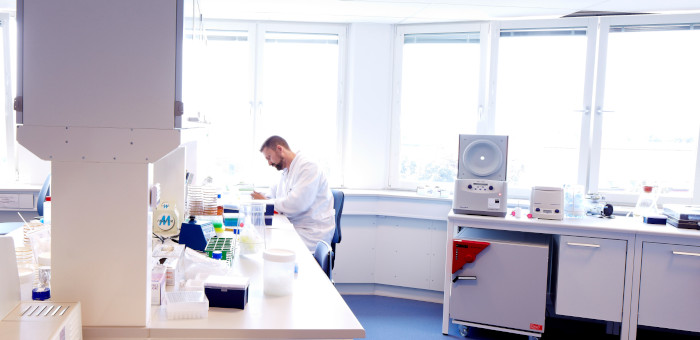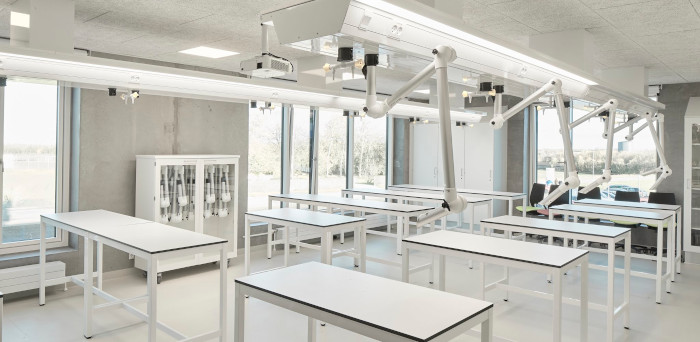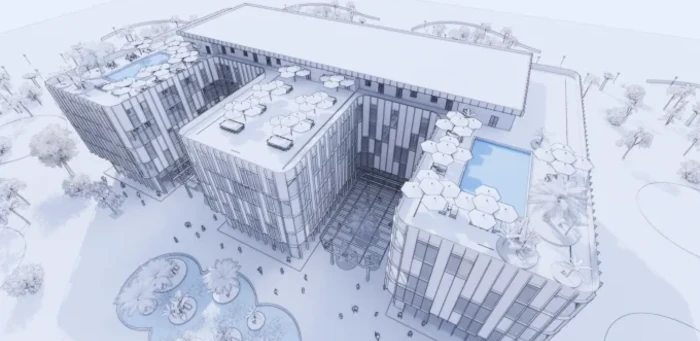Things To Consider
Key factors for the design of the working environment and well-being
Optimum well-being, creativity and productivity do not come by themselves, an important factor is having the correct framework is that you actually invest in the working environment. Ergonomics is just one factor in design – a correct and well-thought-out interior will balance ergonomics perfectly with aesthetics and functionality to ensure the best conditions.
PIC Workflow
Workflow
A room workflow plan includes a list of tasks and processes and the human and material resources required to complete the tasks. In large facilities with a high throughput of people, work processes are often performed simultaneously, and therefore material resources such as equipment and workstations can quickly become limiting. By analyzing the work processes in the laboratory early in the design process, potential problems can be avoided, which will ultimately improve the working environment for the researchers as well as the overall yield of the facility.
An optimized design can minimize the need to move too much around the room, which creates better workflows. The following setups can be used to increase productivity:
U-shaped: Arranging the tables in a U-shaped arrangement means that people can access several different tables with minimal movement. It also ensures that the individual can complete a large number of tasks in the same area.
Z- or S-shaped: Although this solution is rarely used, it can create good opportunities for sharing equipment and workstations.
T-shaped: This setup is advantageous for manufacturing processes with multiple raw materials.
PIC Ergonomi
Ergonomics
Good ergonomic workplaces will usually be adjustable so that it can be adapted to the individual user and work function. Everyone is built differently, so the best ergonomic equipment will take this into account. Adjustable ergonomic equipment means that each user can change the layout according to their own preferences. This means that no one should work at a workplace that is ergonomically adapted to another person, as this would probably lead to injuries in the long run.
The typical health problems that can arise due to poor ergonomics include:
- Eye strain/vision problems
- Pain or numbness in the hands and wrists
- Soreness and pain in the neck, shoulders and back
- Tight or crampy muscles
- Stiff joints
- Other musculoskeletal disorders
Future use and needs
Since installations are usually designed to function for many years to come, the size and layout of rooms is a critical factor. Many laboratories and cleanroom areas are found to be inadequate in several areas: insufficient tables and surface areas, insufficient storage space, lack of flexibility – all of which limit the use of the laboratory.
To avoid this situation, feedback from laboratory staff should be carefully considered along with workflow requirements. Measurements can be made for the space required for different workflows, and extra redundancy can be calculated into the lab to accommodate a given percentage of future growth.
Modular and adaptable
With top-class interior design and openness as a top priority, adaptability will become a primary requirement for workplaces. Here, customization options such as modular furniture will enable organizations to adapt and give the space new purposes depending on the task.
PIC Labmodul 92
Light
When the lighting in the rooms is designed, you have to deal with the individual tasks and set the right requirements.
- Should the light reveal defects on surfaces or degrees of blurring in liquids?
- Should fine divisions on thermometers or pipettes be visible?
- Should the lamps be easy to clean, for example by being completely sealed?
- Are there cleanliness ratings for the room?
- Should the lighting be flicker-free?
- Should the lighting be secured in relation to e.g. ATEX requirements?
- Should the lighting be dimmable?
In general, it is also important to focus on the more general aspects of the lighting, such as glare, horizontal and semi-cylindrical lighting.
Storage
Failure to consider the storage of hazardous products and availability can result in hazardous practices, including storage in unsuitable locations. There is a wide range of storage solutions that are suitable for different tasks, whether it is for storing consumables, chemicals or heavy equipment.
Materials – Especially Surfaces
The choice of materials plays an important role in ensuring a long life of the investment. A typical area for consideration is the worktops, where several factors must be considered, including heat, corrosion resistance, impact resistance and classification. A wide range of different countertop types are available, from the budget option of high-compression melamine faced chipboard to the more advanced options such as solid laminate (HPL), epoxy resin and ceramic countertops.
Cabinets are also available in different materials, including melamine-coated chipboard (MFC) and solid laminate (HPL) or in steel structures made of acid-resistant stainless steel.
Some facilities without climate control and effective shielding against insects, high humidity or pests, cabinets made of galvanized steel can be an advantage.
PIC Special Fume cupboards
CTS For ventilation control
Laboratory ventilation should be carefully considered and should be installed based on the amount of equipment in the laboratory. The more equipment, the more heat generation, and you should therefore analyze the need for ventilation to ensure the well-being of the laboratory staff, as it can be uncomfortable to work in a very hot laboratory. It is not only important for the well-being of laboratory personnel, but also for safety due to the risk of equipment overheating, which also has a negative impact on equipment life and maintenance.




